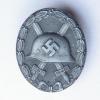Look up my post on French Pneumatic weapons. It is indeed a Italian mortar, used in the French Lance Projector. Italy and France shared a great deal of ordnance details, and it is not uncommon to see designs represented in either country. Below is an image of one in a little better condition. The cap on the front is removable to protect the fuse, which was secured by a pull ring. Once the ring was pulled, the propeller would spin for a predetermined amount of time before stopping and setting the charge off.



